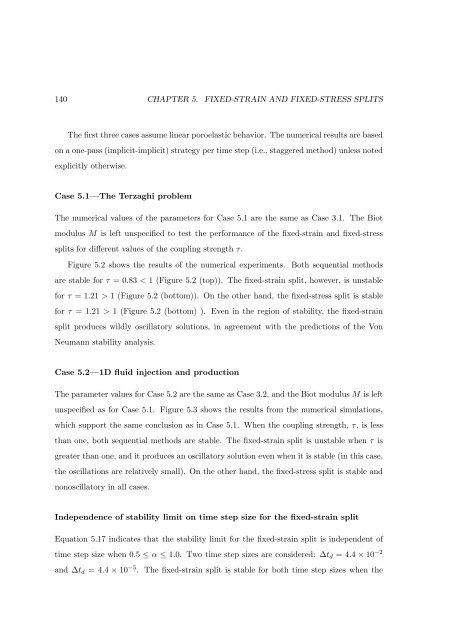Sequential Methods for Coupled Geomechanics and Multiphase Flow
Sequential Methods for Coupled Geomechanics and Multiphase Flow
Sequential Methods for Coupled Geomechanics and Multiphase Flow
You also want an ePaper? Increase the reach of your titles
YUMPU automatically turns print PDFs into web optimized ePapers that Google loves.
140 CHAPTER 5. FIXED-STRAIN AND FIXED-STRESS SPLITS<br />
The first three cases assume linear poroelastic behavior. The numerical results are based<br />
on a one-pass (implicit-implicit) strategy per time step (i.e., staggered method) unless noted<br />
explicitly otherwise.<br />
Case 5.1—The Terzaghi problem<br />
The numerical values of the parameters <strong>for</strong> Case 5.1 are the same as Case 3.1. The Biot<br />
modulus M is left unspecified to test the per<strong>for</strong>mance of the fixed-strain <strong>and</strong> fixed-stress<br />
splits <strong>for</strong> different values of the coupling strength τ.<br />
Figure 5.2 shows the results of the numerical experiments. Both sequential methods<br />
are stable <strong>for</strong> τ = 0.83 < 1 (Figure 5.2 (top)). The fixed-strain split, however, is unstable<br />
<strong>for</strong> τ = 1.21 > 1 (Figure 5.2 (bottom)). On the other h<strong>and</strong>, the fixed-stress split is stable<br />
<strong>for</strong> τ = 1.21 > 1 (Figure 5.2 (bottom) ). Even in the region of stability, the fixed-strain<br />
split produces wildly oscillatory solutions, in agreement with the predictions of the Von<br />
Neumann stability analysis.<br />
Case 5.2—1D fluid injection <strong>and</strong> production<br />
The parameter values <strong>for</strong> Case 5.2 are the same as Case 3.2, <strong>and</strong> the Biot modulus M is left<br />
unspecified as <strong>for</strong> Case 5.1. Figure 5.3 shows the results from the numerical simulations,<br />
which support the same conclusion as in Case 5.1. When the coupling strength, τ, is less<br />
than one, both sequential methods are stable. The fixed-strain split is unstable when τ is<br />
greater than one, <strong>and</strong> it produces an oscillatory solution even when it is stable (in this case,<br />
the oscillations are relatively small). On the other h<strong>and</strong>, the fixed-stress split is stable <strong>and</strong><br />
nonoscillatory in all cases.<br />
Independence of stability limit on time step size <strong>for</strong> the fixed-strain split<br />
Equation 5.17 indicates that the stability limit <strong>for</strong> the fixed-strain split is independent of<br />
time step size when 0.5 ≤ α ≤ 1.0. Two time step sizes are considered: ∆td = 4.4 × 10 −2<br />
<strong>and</strong> ∆td = 4.4 × 10 −5 . The fixed-strain split is stable <strong>for</strong> both time step sizes when the
















